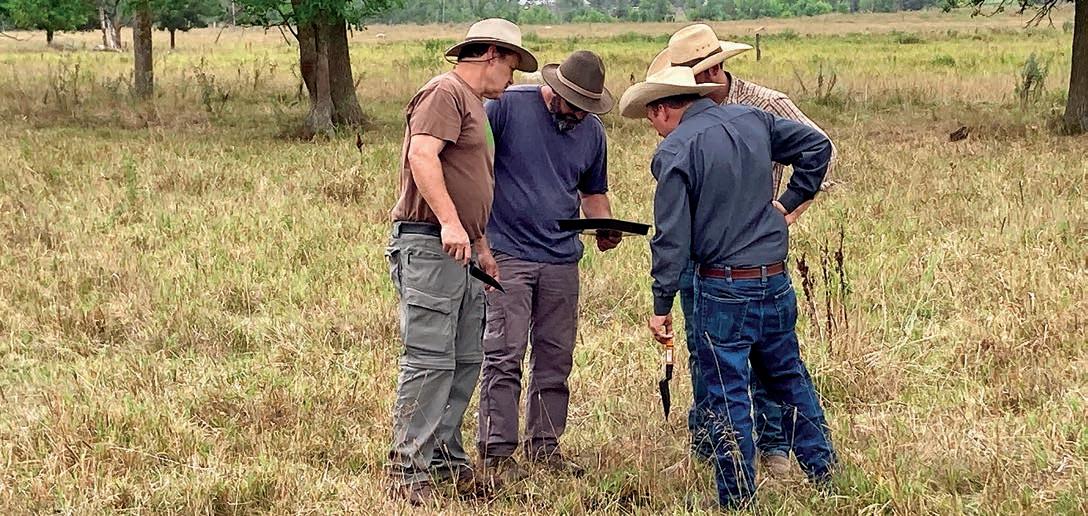
5 minute read
Dung beetles play an essential role in your pasture's ecosystem
Attendees of a dung beetle workshop investigate a cow pie on Thursday, Aug. 24, 2023, near Pine River, Minnesota. Michael Johnson / Agweek
By Michael Johnson | Agweek
PINE RIVER, Minn. — On a cloud covered August afternoon, a group of about 20 farmers, ranchers, scientists and just plain curious folks had their eyes to the ground as they shoveled through cow pie after cow pie.
“Pick up the crust, flip it over … if it moves grab it,” Roger Moon explained as the group dug in around him.
Moon knows cow pats and what resides in them better than most after more than 40 years of research work on the steamy subject. Moon is professor emeritus of veterinary entomology with the University of Minnesota’s College of Food, Agricultural and Natural Resource Sciences in St. Paul.
The attendees searched through three different paddocks on the rotational pastures owned by Thomas Stattelman of the Stattleman Angus Ranch outside of Pine River.
Each of the paddocks were grazed about a week apart and those digging into the dung could catch a glimpse of what critters remained in each of the aging cow pies.
“If you can find like one of these little balls, pick it up,” Moon said unabashedly holding some dung with his bare hands. “It’s easy to see the burrowing holes in the bottom and that’s a sign that dung beetles are working that dung and taking it down into the soil below. That’s a good thing.
“Look for the signs of insects even if you can’t find the insects,” he added. “Holes mean beetles, basically.”
The presence of beetles, which eat and carve out caverns through the drying dung, means that the dung is being processed. The beetles help to break up that dung faster than it would without them. That’s important on these pastures. The dung needs to break up and absorb into the soil so the ground is clear of manure and free to go back to growing a plethora of forage for the cattle.
Attendees like Kelly Anderson, a grazing and livestock specialist with the Minnesota Department of Agriculture, dug in and began finding some dung beetles, their tunnels — and a whole lot of other creatures. Maggots, earthworms, various flies and larvae all were finding a meal among the “meadow muffins,” as Moon affectionately calls them.
“This one is probably old enough that a fly or something came in, laid an egg, and the larvae has already hatched and flown away,” Anderson said. While the average person, including many on this tour, don’t put much thought into what goes on in a cow patty, Anderson admits she has spent considerable time on the subject.
In her work with the Department of Ag, she researches cattle that are put out onto public land. It’s key that the cattle are not going out with chemicals in their dung that may be harmful to the insects there, including pollinators.
She was able to nab one dung beetle while out. They are dodgy little bugs and able to scurry undercover in a hurry.
While some bugs, like the dung beetle, were there to eat dung, others were there to tunnel through in search of larvae to eat. No matter their reasoning, they were breaking up the dung, and that’s a sign of a healthy pasture.
With 110 cow-calf pairs and with the cattle each defecating about once every 2 hours, it doesn’t take long to amass quite a bit of manure at the Stattelman Ranch. While fewer bugs are often a positive for people, it’s a sign of deficiency in a pasture, Moon explained. He made note of one key early on in the discussion that the timing of dewormer in a herd can make a difference. Several attendees, such as Dayle Reinke, of rural Wadena, noted that they use a dewormer around Thanksgiving for their rotationally-grazed cattle. Doing so then means it will run its course through the herd long before grass starts to grow again.
Moon explained that using a dewormer while the grass is growing is a good way to kill off populations of dung beetle, which follow behind the herd. He suggested avoiding treatments in the summer but that Moxidectin was the safest treatment for dung beetles. In any case, he suggested testing worm eggs per gram to determine of a herd treatment is needed.
Stattelman understands that microorganisms are important. He does not use any commercial fertilizer and has not sprayed any chemical on the pastures in the last six years. He said he uses no fly control, either.
“It’s about as all-natural as you can get here,” Stattelman said. He’s the third generation of the Stattelmans to work this land.
His operation includes about 850 acres of rolling hills with a smattering of trees to shade the herd. He moves his cattle roughly every week, with a total of about 16 paddocks. He calves in the spring and sells the calves in the fall.
There were a few surprises on the tour.
“Honestly I didn’t even know we had dung beetles,” Stattelman said. He said he now understands better their importance to the cattle grazing cycle.
After collecting specimens from the pasture, the group returned to the ranch and sorted through the bugs. Moon talked about what they were seeing and what that might mean. He gave the findings a good grade.
The event was hosted by the Crow Wing River Basin Forage Council, a networking group of the Sustainable Farming Association.





